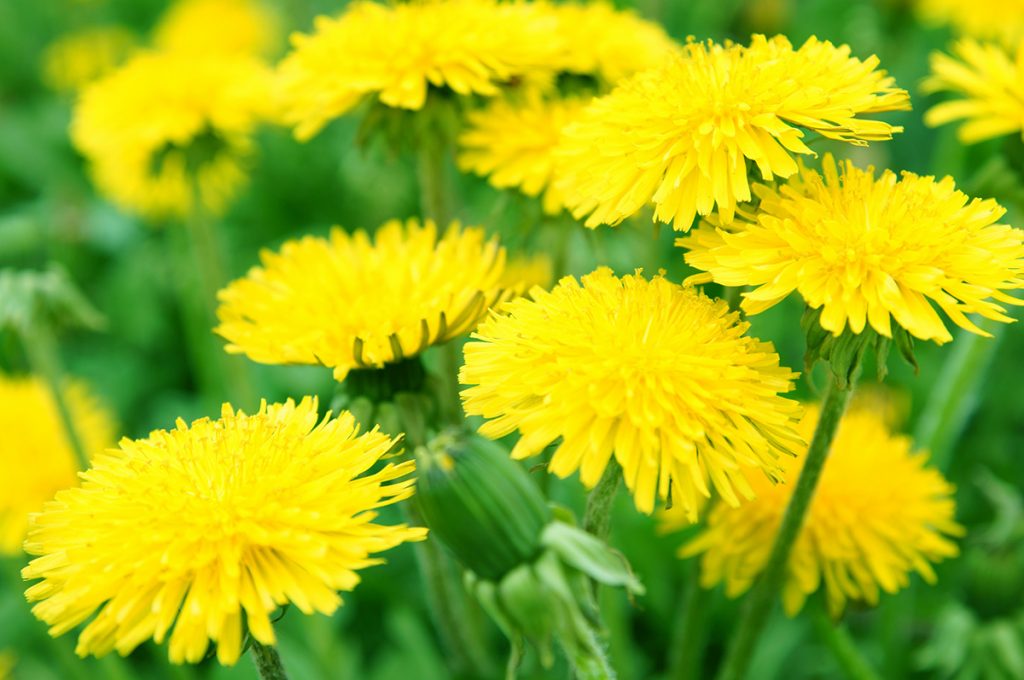
Looking for a natural solution to your pain woes? Say hello to dandelion pain balm! Yes, you read that right – the very same plant that’s often considered a pesky weed in your garden could be the answer to your aches and pains. Dandelion pain balm is a topical ointment made from dandelion extract that has anti-inflammatory and pain-relieving properties. Keep reading to find out how dandelion pain balm could be your new go-to for all kinds of pain relief.
You know spring has arrived when the dandelion flowers start to bloom. These are usually the first flowers to bloom in the spring. Dandelion flowers are an important food source for honey bees after the long cold winter ends. Did you also know that this “weed” is actually a superfood that is packed with vitamins and minerals?
It’s not just the dandelion flowers that are beneficial. The whole plant can be used and is edible and nutritious. I’ve posted a more in-depth article on the many uses for dandelion in this post. But here is a video showing something else you can do with dandelion flowers.
Focus on Dandelions
I want to focus on using the flowers in an oil infusion to make this dandelion pain balm. You can use this balm to treat sore joints and muscles, as well as treat dry, chapped skin.
Dandelion flowers contain high amounts of vitamins A, C, and K. They also have smaller amounts of vitamin E and other B vitamins. They contain essential minerals such as calcium, magnesium, potassium, and iron. They also contain antioxidant compounds and may have analgesic properties. This is what makes this infused oil so beneficial for your skin and useful to help with sore joints and muscle pain.
Gather Supplies
You’ll want to make sure you have the following supplies on hand before you harvest your dandelion flowers. If you don’t have all the supplies on hand you can harvest and freeze them until you do.
- Quart Glass Jar
- Food Processor or Blender (Optional)
- Crock-Pot (To Heat The Oil)
- Small Jars or Tins (For Storing Your Balm. Buy Here)
- Bees Wax Pellets (Buy Them Here)
- Shea Butter (Buy Here)
- Carrier Oil (Your Choice)
- Measuring Cup
- Reusable Coffee Filter (Optional- Useful for pressing the oil out of the petals when you strain the oil.)
- Cooking Thermometer (To Monitor The Temperature Of The Oil)
- Essential Oils (Optional)
Harvesting Dandelion Flowers
To harvest dandelion flowers you can simply cut them from the stem right below the green part underneath the yellow flower head. Rinse them to remove any dirt or debris. Shake off as much water as possible and then lay them out on a towel to dry. I use a small fan on low blowing over them to help with drying.
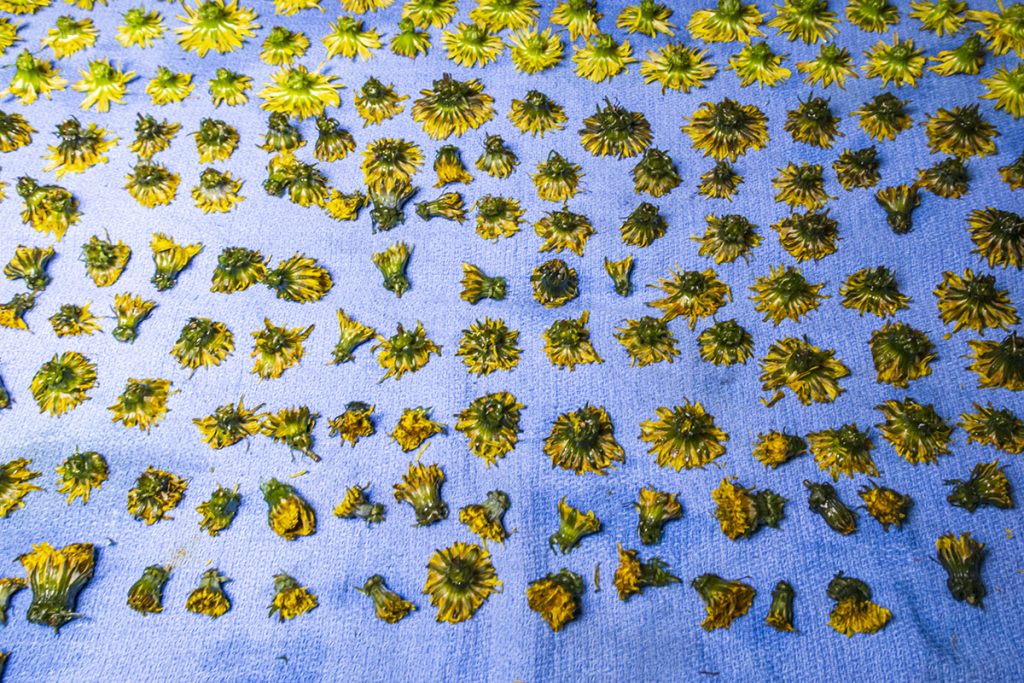
Making Infused Oil for Dandelion Pain Balm
Now we are ready to start infusing our oil to extract the goodness from the dandelion flowers. Simply place the whole flowers in a jar as shown below and then add enough carrier oil to cover the flowers completely.
Once you have transferred the dandelion flowers to your glass jar you will then need to add a carrier oil such as olive, almond, jojoba, grape seed, or other oil of your choice. I like to use sweet almond oil because it is great for the skin and absorbs fairly quickly. You can purchase carrier oils here.
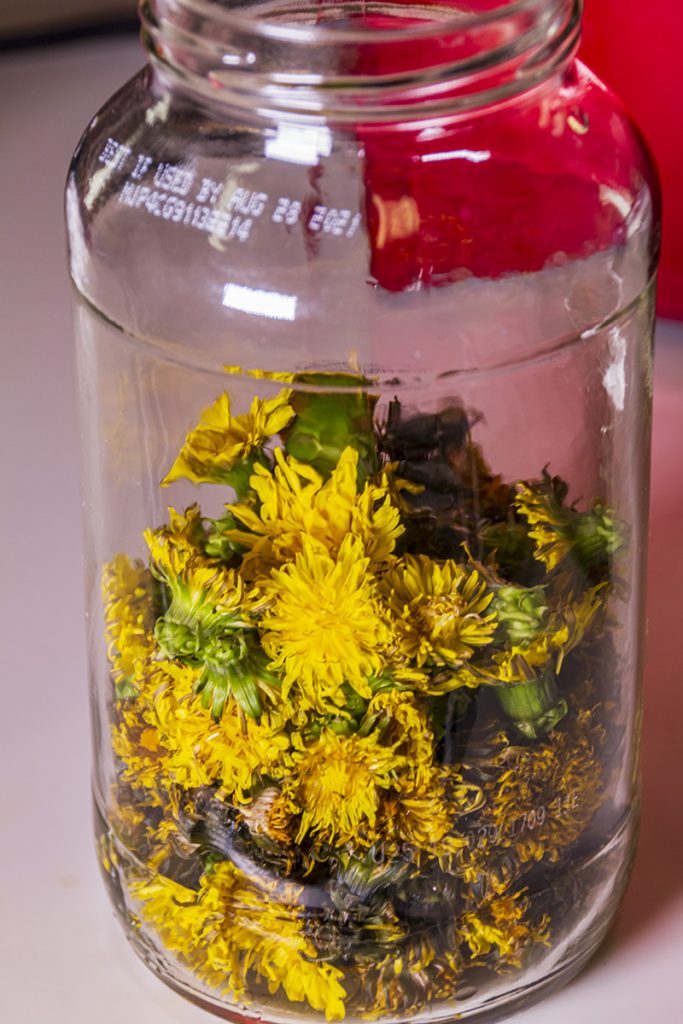
Gentle Heating Method for Infused Oil
Cover the jar to prevent dust or mold spores from getting into the oil while we are gently heating the mixture. I use a coffee filter and use old bread ties to keep the filter secured on the jar. You can also use a rubber band over the coffee filter and around the mouth of the jar. Using a coffee filter allows water to evaporate from the oil should any find its way into your infusion.
Place the jar in a Crockpot or double boiler and heat the mixture on low heat for 48-72 hours. I prefer to leave mine for 72 hours to get the most out of my infusion. You’ll want to keep the temperature of the oil between 120-140 degrees F. Use a cooking thermometer to monitor the temperature. You don’t want to burn your precious oil.
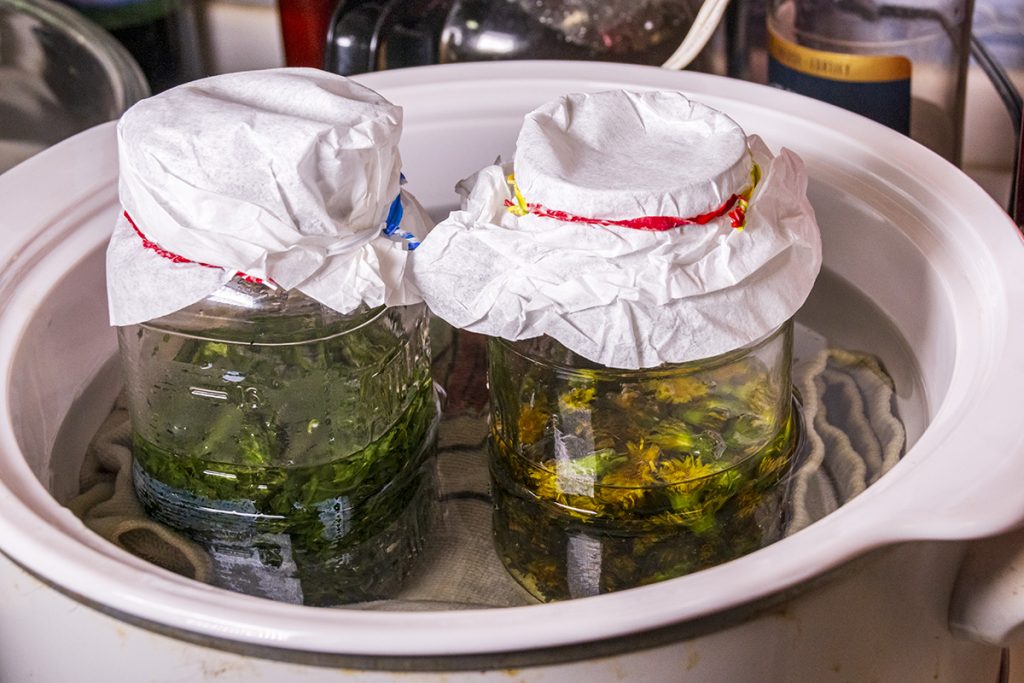
As you can see in the photos I was also making a batch of plantain-infused oil at the same time. You can read about plantain and the benefits of plantain-infused oil here.
Place a hand towel in the bottom of the Crockpot, place your jars on top of the towel, and fill it with warm water to cover the jars about halfway. If the water level gets low carefully add water back up to the halfway point of the jars. After about 72 hours your oil is ready to be used to create your balm.
Note- The old-fashioned way to create an oil infusion is to simply prepare your jars and then set them in a sunny window for 4-6 weeks, stirring them occasionally. I don’t have that kind of patience.
Once the oil is finished I use a reusable fine mesh coffee filter to strain the oil. Then I can press the flowers to extract as much of the oil as possible. Little, if any goes to waste.
Whichever way you choose to infuse your oil it should come out with a beautiful golden color as shown below.
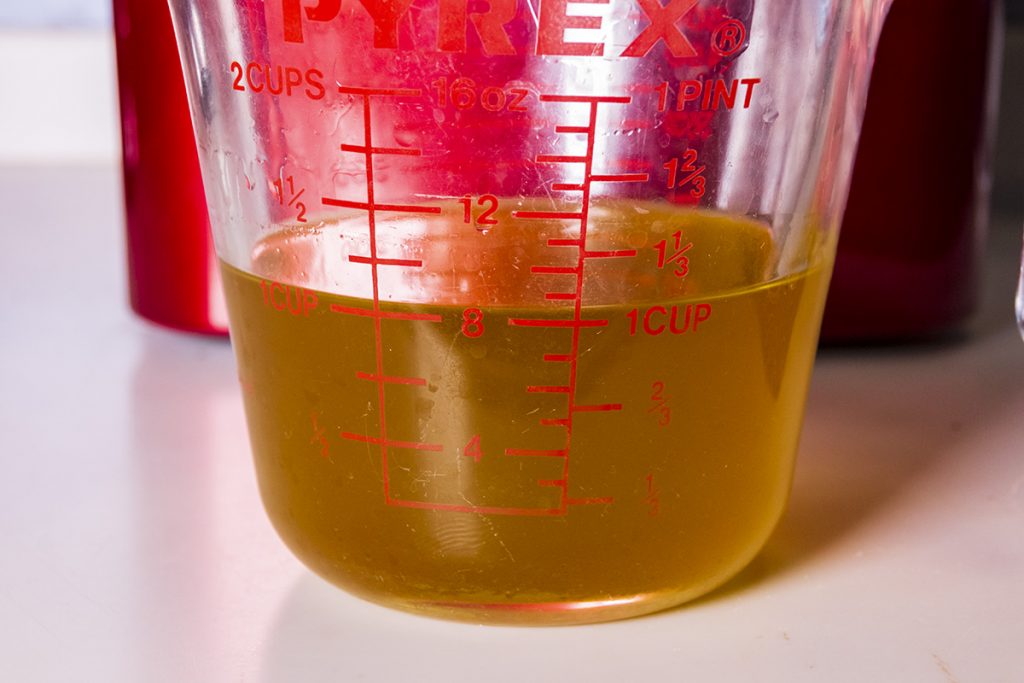
Preparing Dandelion Pain Balm
Now we are ready to prepare and bottle our dandelion pain balm.
Melt Beeswax and Shea Butter
The next step is to use a double boiler to melt 2 tablespoons each of beeswax and shea butter. Shea butter is another wonderful plant substance. It is sourced from Africa. It is used in all kinds of skin care products and is wonderful for your skin.
Gently heat the beeswax and shea butter until they are totally melted, stirring frequently. This recipe will fill three 8-ounce jars, which for me is about a 1 year’s supply of dandelion Balm.
Mix Together With Infused Oil
Once the shea butter and beeswax are dissolved, carefully stir the warm mixture into your infused dandelion flower oil and stir vigorously to mix well.
Add Essential Oils
Let the mixture cool slightly, but not so cool that it begins to harden. I add essential oils at this point and mix them in prior to bottling. If the mixture is too hot the volatile essential oils will evaporate away.
I add 25 drops each of copaiba and black pepper essential oils. Copaiba oil is a natural pain reliever and contains b-caryophyllene. The percentage of b-caryophyllene found in Copaiba essential oil is 50-60%. B-caryophyllene found in Copaiba oil binds directly to CB2 receptors in the body. It has been shown in studies with mice to have analgesic and anti-inflammatory pain relief properties. The pain-relieving constituents in CBD oil are anywhere from 2-30%. You can read more about Copaiba essential oil in this article. Black pepper is known as “hot” oil and has analgesic and anti-inflammatory effects. It also increases blood flow to the affected area.
Add Vitamin E Oil
Once all the ingredients are mixed together I also add 5 drops of Vitamin E oil before I pour the mixture into storage jars. Vitamin E oil is good for your skin and also acts as a preservative. The mixture will harden slightly as it cools. I prefer to place mine in the refrigerator. I store them there to prolong the useful life of the balm and to prevent mold from growing in case any moisture happens to remain in the balm.
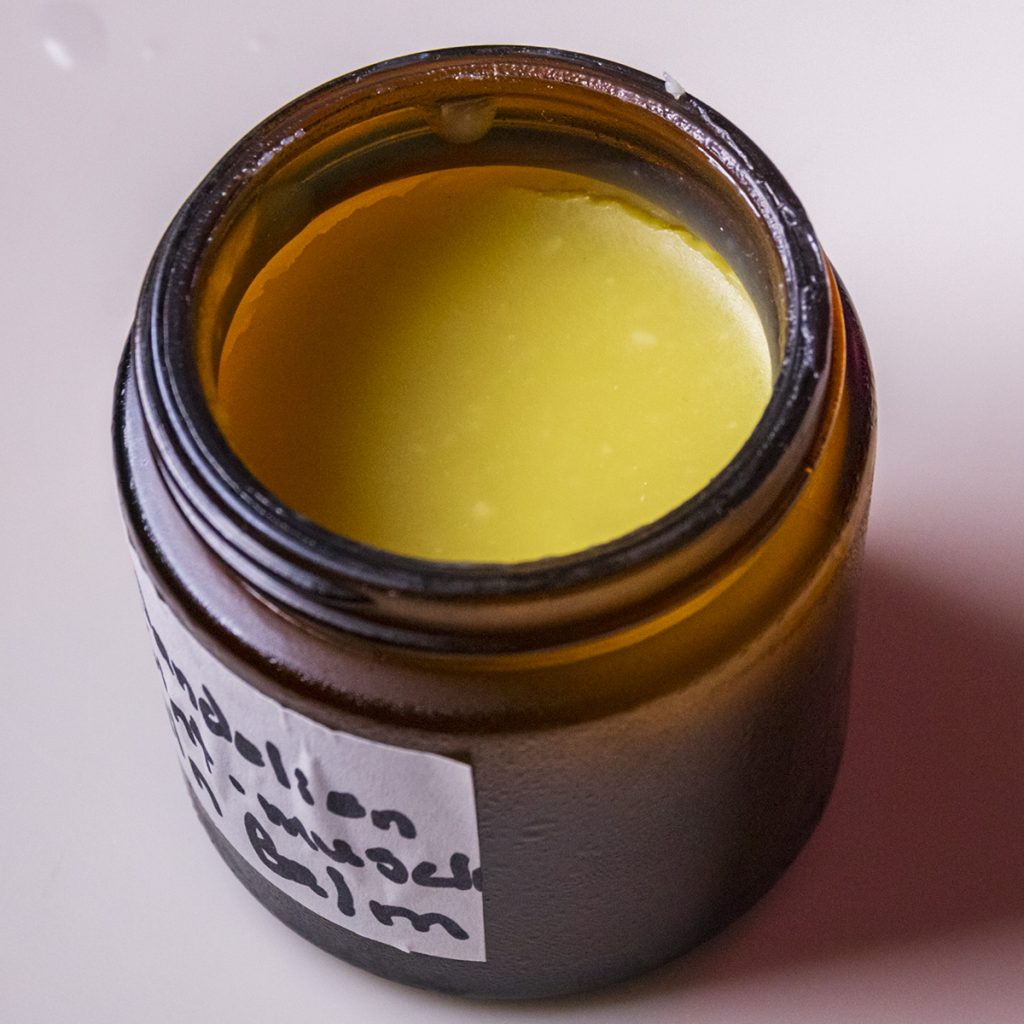
Now you can reach for your healing balm anytime you need it. It is great for tired achy muscles, achy joints, and may help protect your skin from sun damage.
Note that this balm and the infused oil are for external use only. Do not ingest the oil or the balm. If you have a condition that does not respond or gets worse, seek medical attention. If you have allergies to dandelion you should avoid the use of this or other products containing dandelion.
Disclaimer: This article should not be construed as medical advice. The health information in this article is not intended to assess, diagnose, prescribe, or promise a cure for any medical condition. Consult with your health care professional before considering any natural supplement or plant remedy for your health and wellness. We assume no liability for the use or misuse of the material presented above. Always consult with a medical professional before changing your diet, or using natural home remedies.
Be sure and check out all the informative articles on our Natural Living Blog.
FAQs:
Q: What is dandelion balm?
A: Dandelion balm is a topical ointment made from dandelion flowers or roots that are infused in a carrier oil and combined with other ingredients such as beeswax or shea butter. It is commonly used to soothe and heal skin irritations, inflammation, and pain.
Q: What are the side effects of dandelion salve?
A: Dandelion salve is generally safe for most people, but in rare cases, it may cause allergic reactions or skin irritation. It is recommended to do a patch test before applying it to a larger area of skin. Dandelion may also interact with certain medications, so it is important to talk to a healthcare provider before using it.
Q: How is dandelion used for skin?
A: Dandelion can be used for skin in various ways, including making a salve, oil, or tea. It contains antioxidants, anti-inflammatory properties, and vitamins that are beneficial for skin health. Dandelion can help soothe and heal skin irritations, reduce inflammation, and prevent acne. It can also be used as a natural toner or to brighten the skin.
Q: How do you use dandelion for pain?
A: Dandelion can be used for pain relief by making a salve or oil. It can be applied topically to the affected area and massaged gently into the skin. Dandelion can help relieve pain and inflammation in conditions such as arthritis, muscle soreness, and menstrual cramps.
Q: How do you make dandelion pain killer?
A: To make dandelion pain killer, you can infuse dandelion flowers or roots in a carrier oil such as olive or coconut oil for several weeks. The infused oil can then be combined with beeswax or shea butter to make a salve. Other ingredients such as peppermint or eucalyptus oil can be added for added pain relief.
Q: Is dandelion salve good for pain?
A: Yes, dandelion salve can be effective for pain relief. Dandelion contains anti-inflammatory properties that can help reduce pain and inflammation in conditions such as arthritis, muscle soreness, and menstrual cramps.
Q: What is the best carrier oil for dandelion salve?
A: The best carrier oil for dandelion salve depends on personal preference and skin type. Some popular options include olive oil, coconut oil, jojoba oil, and sweet almond oil. It is important to choose a high-quality carrier oil that is cold-pressed and unrefined for best results.
Q: How long is dandelion salve good for?
A: The shelf life of dandelion salve depends on the ingredients and storage conditions. Typically, dandelion salve can last up to six months to a year when stored in a cool, dry place. It is important to discard the salve if it develops an unusual odor or color.
Q: Who should avoid taking dandelion?
A: Dandelion is generally safe for most people, but it may interact with certain medications such as diuretics or blood thinners. People with ragweed allergies or those who are pregnant or breastfeeding should avoid taking dandelion. It is recommended to talk to a healthcare provider before taking dandelion if you have any underlying medical conditions.
Q: What part of dandelion is medicinal?
A: Both the leaves and roots of dandelion have medicinal properties. Dandelion leaves are rich in vitamins and antioxidants and are commonly used in teas and salads. Dandelion roots contain bitter compounds and are used to make dandelion root tea or tincture.